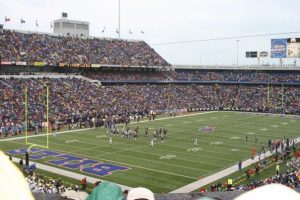When you hear the name F. Scott Fitzgerald, what’s the first thing you think of? For many in our generation, it’s Gatsby, of course. But when Fitzgerald died in 1940, it wasn’t The Great Gatsby that was mentioned in several obituaries. It was his first work, This Side of Paradise, that the papers focused on, what they claimed to be the young author’s masterpiece. A reader in 2015 would be puzzled by this fact. After all, Gatsby is all the rage for our generation. Gatsby, Gatsby, Gatsby – we have a fascination with this literary giant comparable to Jay’s fascination with Daisy, or Jordan’s fascination with large parties (after all, they’re just so intimate). What is it about The Great Gatsby that speaks to us? And why do we just stop there when considering Fitzgerald’s life and literary career?
As an English major with an affinity for older literature, I decided to challenge myself by taking Professor Corrigan’s class, Fitzgerald and his Circles. After publishing her famous analysis So We Read On, Corrigan has decided to teach about her favorite author, Fitzgerald himself. Yet to find our way to a fuller understanding of Gatsby, we first have to tackle Fitzgerald’s prior novels and short stories. I picked up This Side of Paradise, Fitzgerald’s first novel, with uncertainty.
After hearing that Fitzgerald rewrote and resubmitted the work to Scribner’s three times before being published, I expected the novel to be a bumbling amalgamation of several works, submitted by a nervous young man determined to make enough money to win his future bride, Zelda. What I found instead, however, was a beautiful literary work, something that truly has helped me realize Fitzgerald’s genius – and also led me to wonder just how much emphasis we should be putting on Gatsby itself.
The Great Gatsby will always capture— and run away with— our imaginations. We are rapidly swept into the swirling social scene, the unattainable allure of West Egg life, the battle between old and new money. Reading Gatsby is what prompted me to fall in love with the roaring 20s. Yet, all of the characters in Gatsby are almost too great. Their pursuits, their goals – they’re not things the everyday person would think of. The Daisy Buchanans and Nick Carraways of the world already have it all; they just want more.
Now let’s compare these giants to Mr. Amory Blaine of This Side of Paradise, the spitting image of a young Fitzgerald himself. Amory is selfish, aloof, and devilishly good-looking – but he is constantly the man on the outside looking in. From his youth to his years at Princeton, all of Amory’s goals have been to fit in, to know where he belongs. Amory consistently looks to challenge himself, to be well liked by his peers, and to feel some sense of fulfillment as he matures. When he falls, sometimes he picks himself up again. Other times, he drifts.
Like most of us, Amory has also fallen in love a few too many times – and often, with the wrong person. Playing the role of the good guy attracted to the bad girl, Amory often finds his heart wrenched by the social vamp, the flapper girl ready to take on the world as it is presented to her. Through every up and down, through the defiance of social constructs and the dawn of Prohibition, Amory Blaine is just trying to figure out exactly who he is in this speeding, never-ending world – and if that’s just enough to keep up.
Aren’t we all a bit like Amory Blaine? In the end, isn’t keeping up and staying afloat all we’re trying to do when we get to college? Though some of us came to the Hilltop with a distinct idea of who we want to be, and when we want it done, many of us did not. We signed our admission to Georgetown with starry eyes and an uncertainty towards the future, hoping to find out exactly who we are as we faced the most exhilarating, and challenging, four years of our lives. Amory’s quest for self-discovery and self-fulfillment is a sentiment that I know every college student can relate to. Because it is only once we discover how we truly tick, what truly either sets us back or motivates us to move forward, that we can embrace the challenges that this dizzying world has to throw at us.
This Side of Paradise is Fitzgerald’s bona fide bildungsroman novel, brilliantly portraying the growing pains that any adolescent or young adult experiences. While we can sympathize with Jay Gatsby as he swoons and romanticizes over the slightly ditzy Daisy, I feel a stronger connection to Amory Blaine. I know that sensation of walking onto a campus for the first time, separated from your family, and feeling both exhilaration and dread. Of journeying into a dark unknown trying to find the you coming up ahead. And the sensation of falling, and having to look within to determine whether or not to get back up again or to stay on your back as you let the storm pass.
The Great Gatsby is a story of giants. But This Side of Paradise is the story of the young, one that I think every college student my age would automatically connect to in ways they simply couldn’t with the Buchanan clan.Of course, I love The Great Gatsby. But after reading This Side of Paradise, I was able to see another side of Fitzgerald, one that I thoroughly encourage my fellow college students to explore. One man’s legacy shouldn’t be solely defined by a blinking green light.
Photos: o.onionstatic.com, mundodamarina.com




